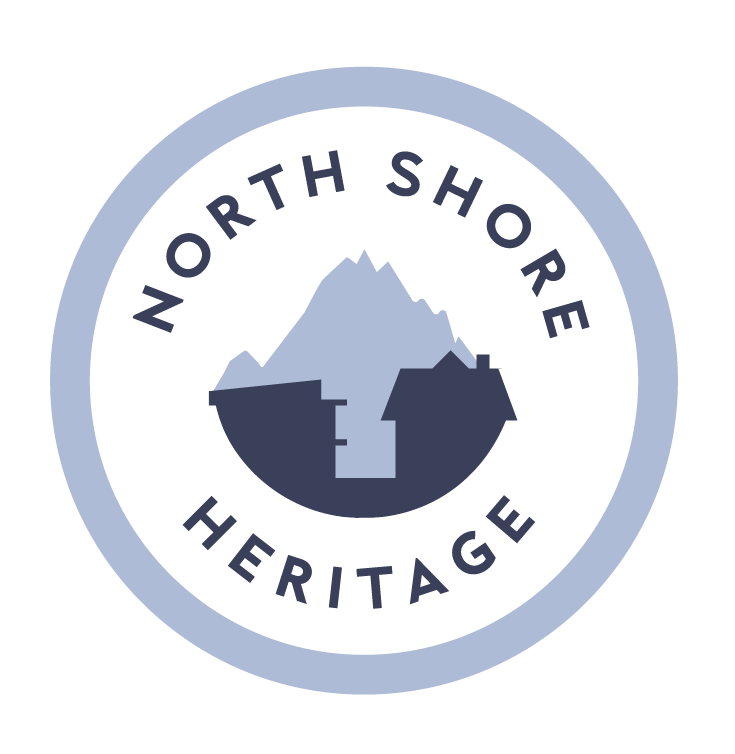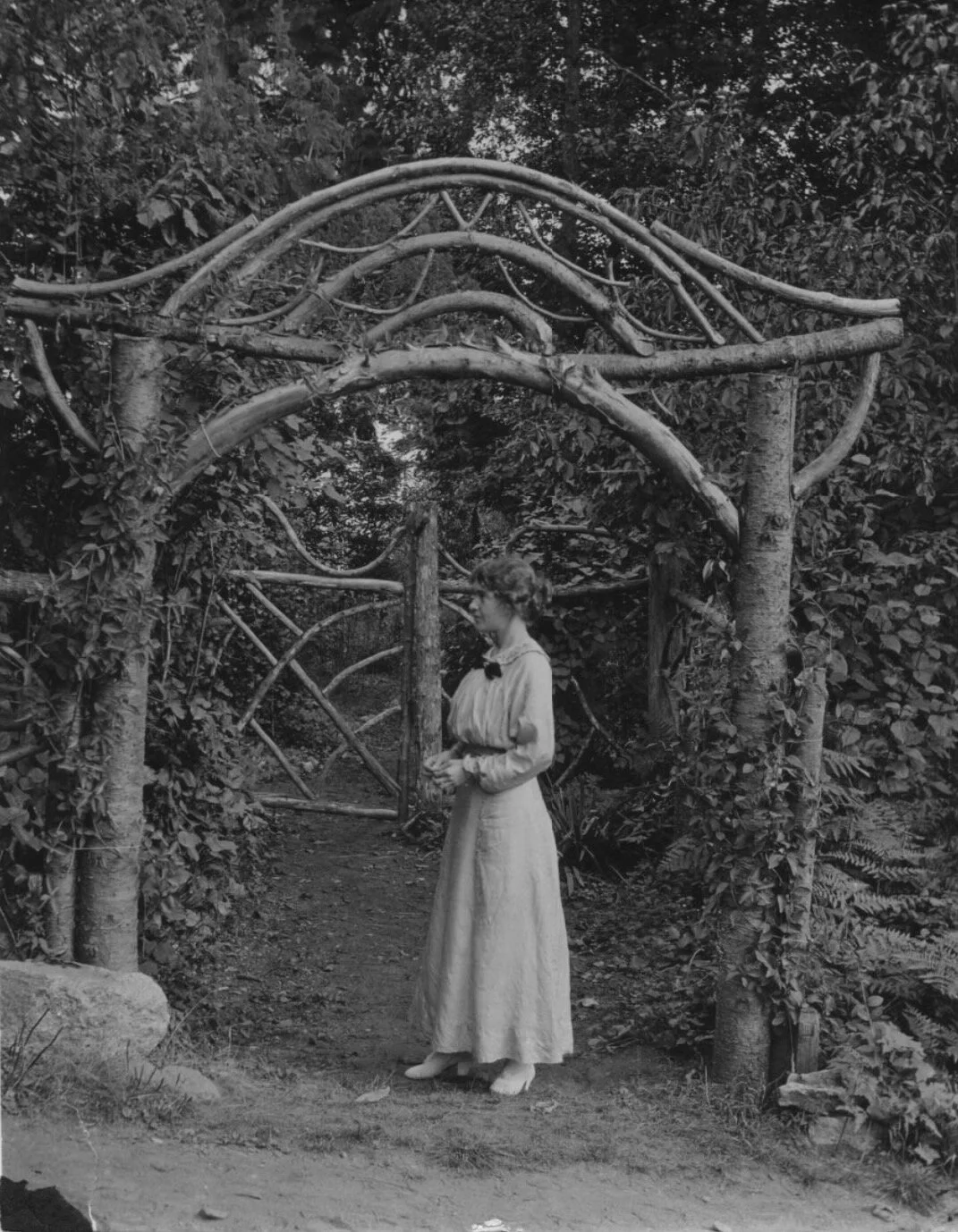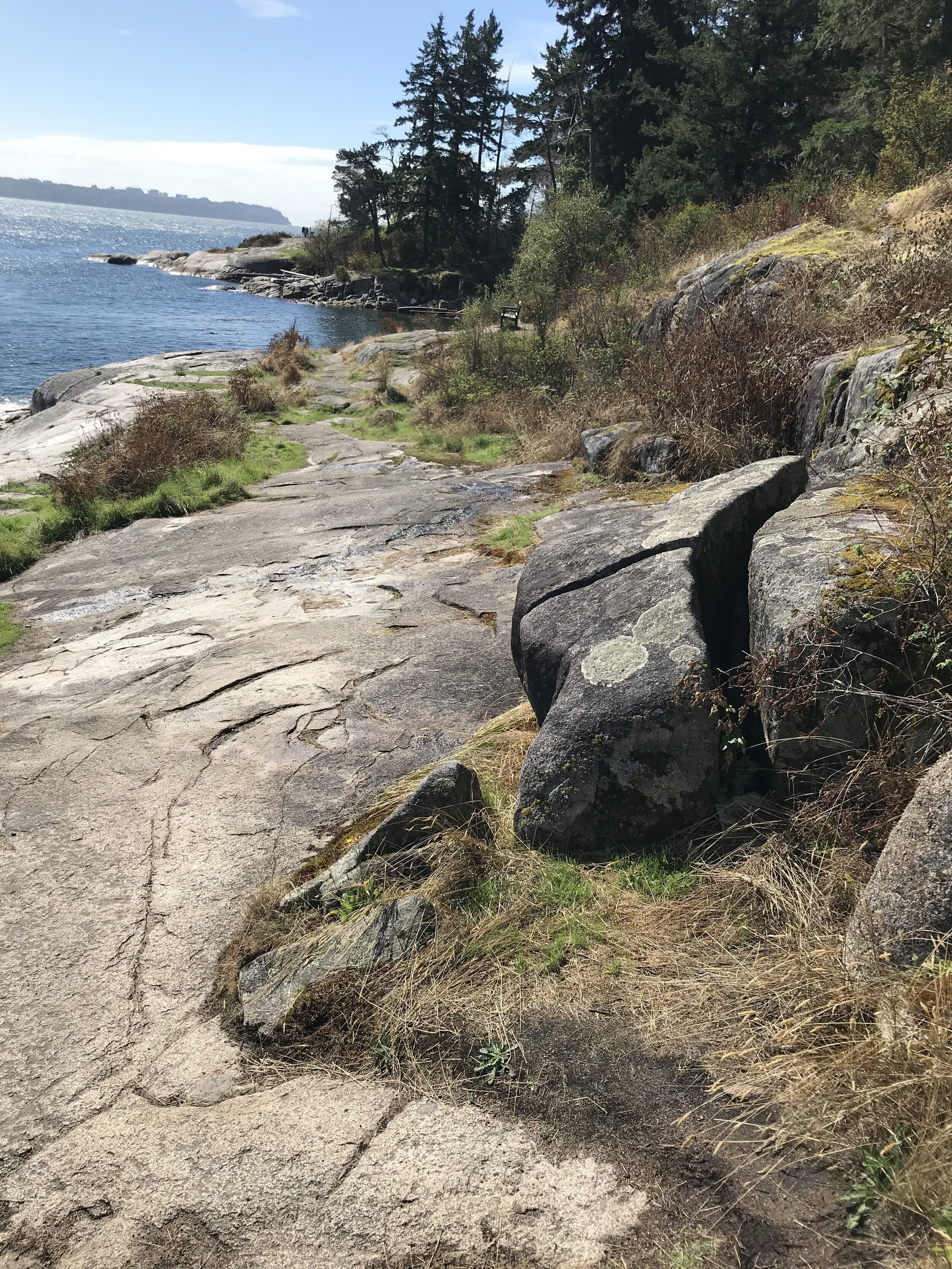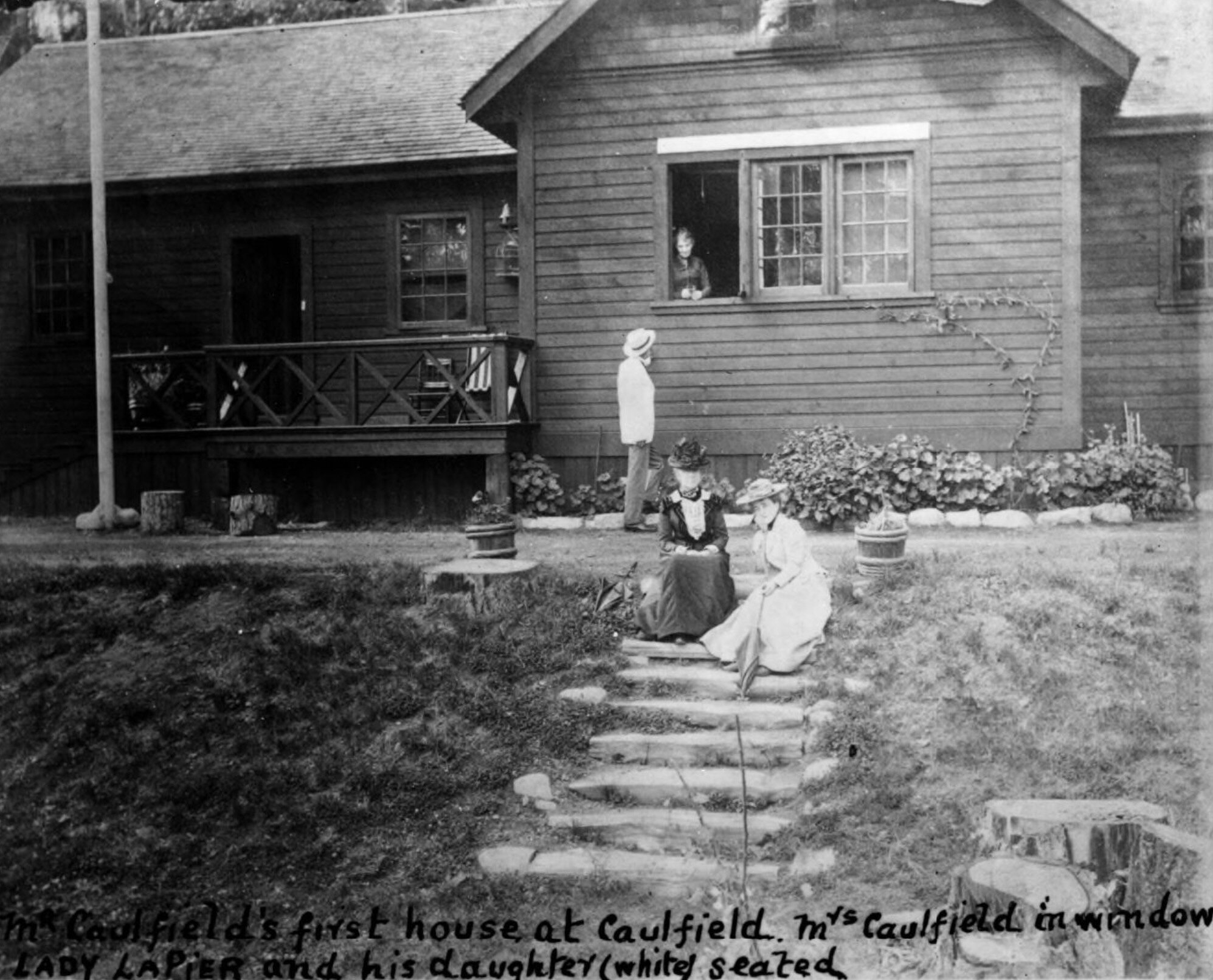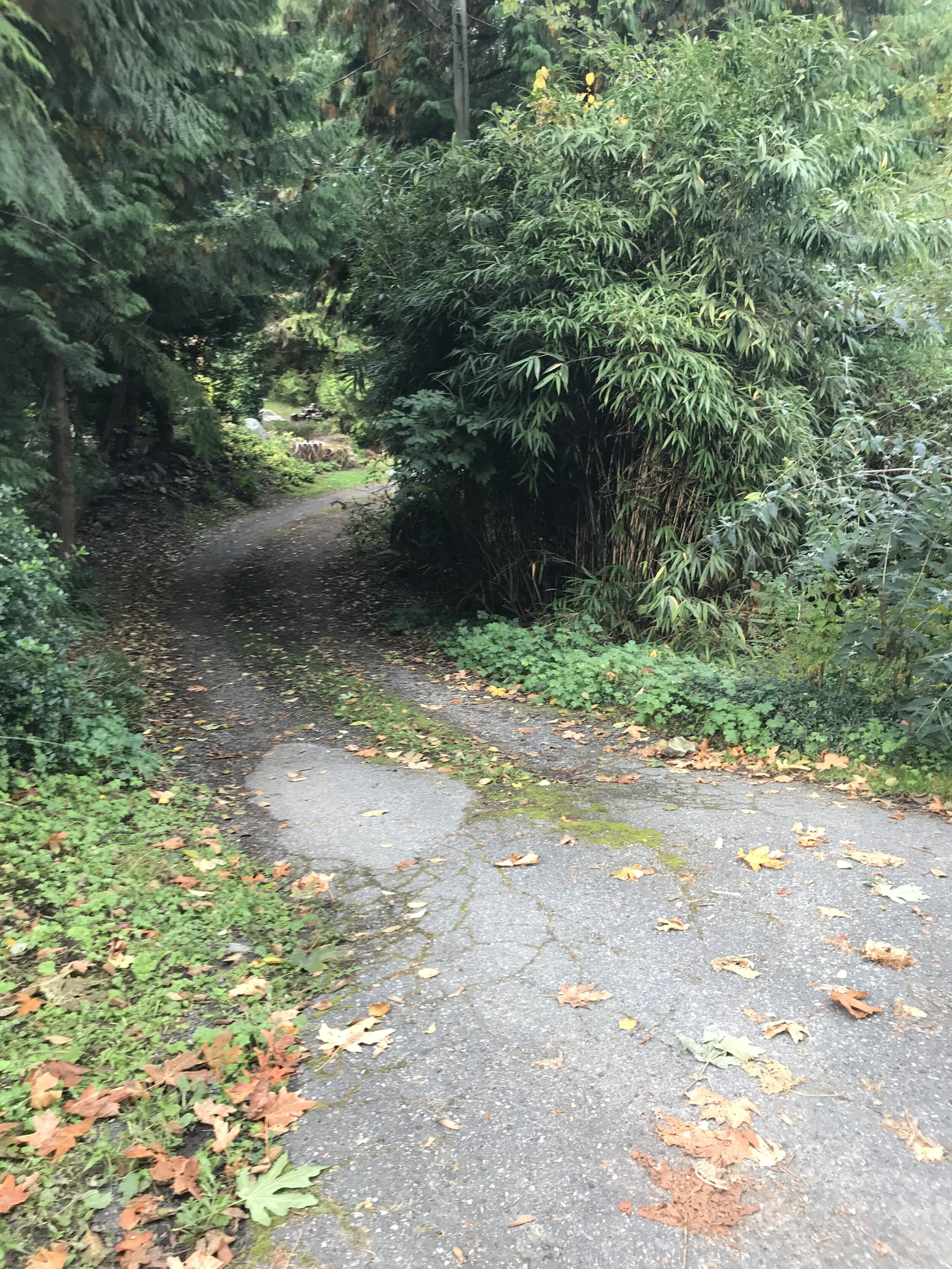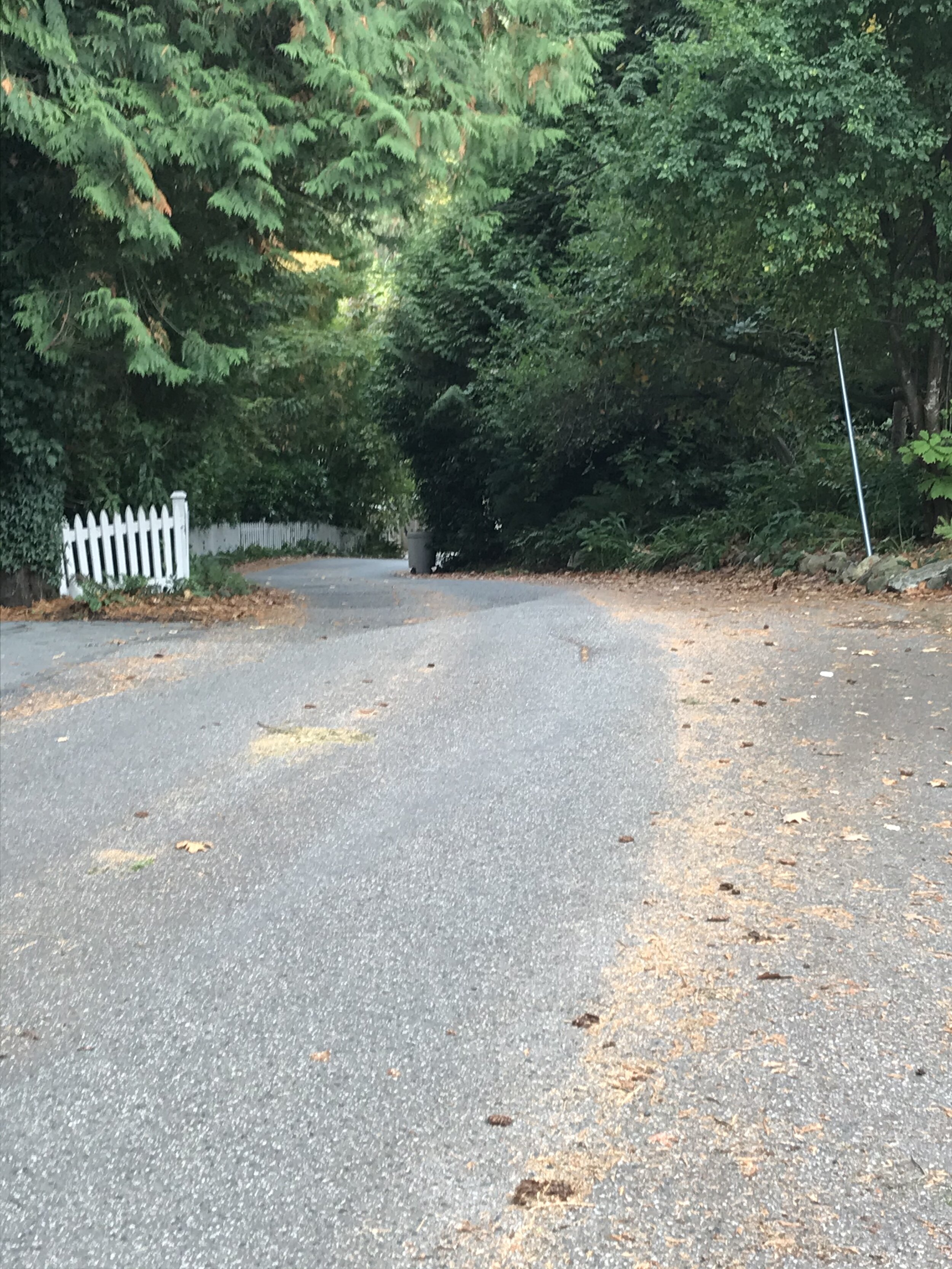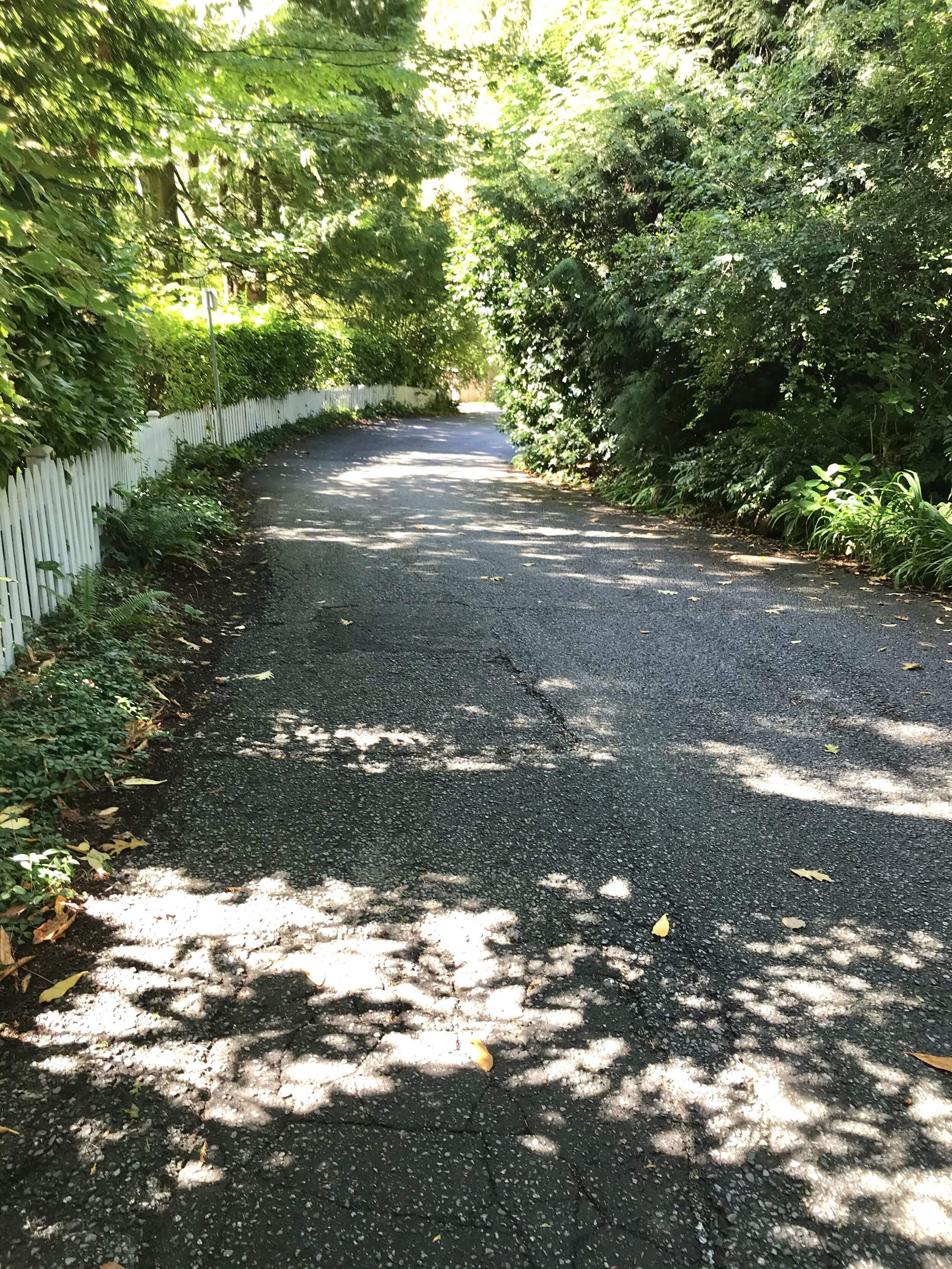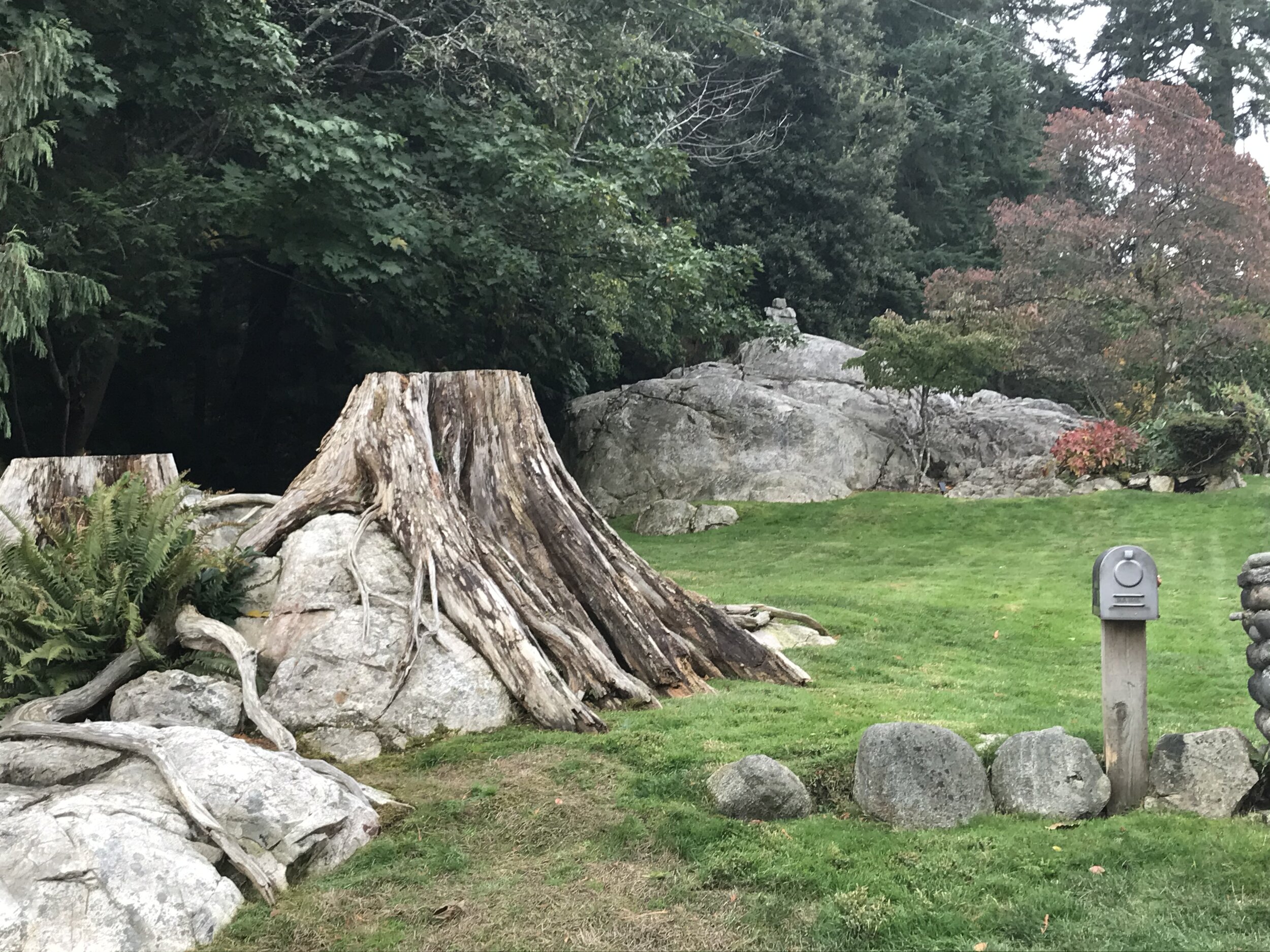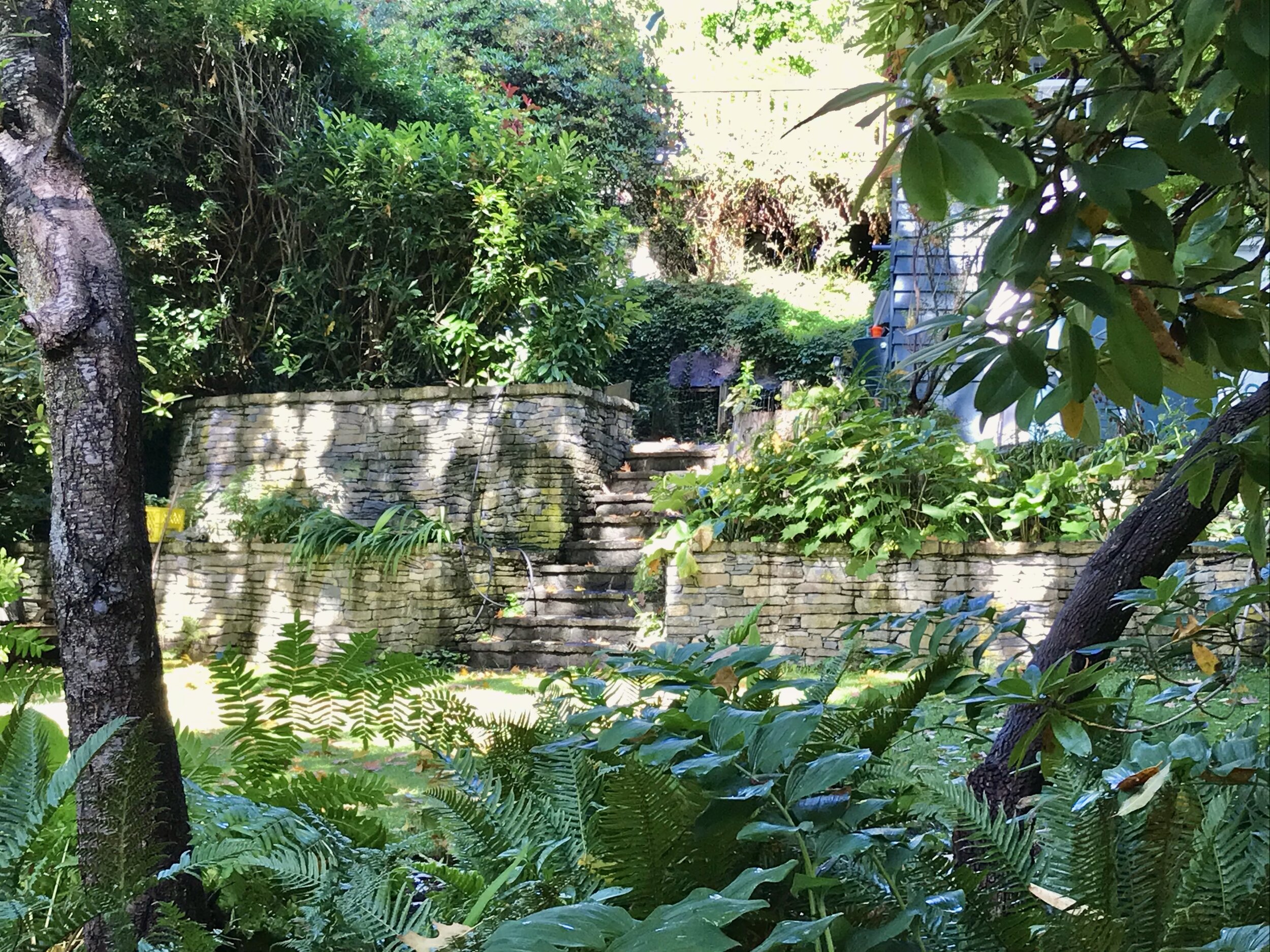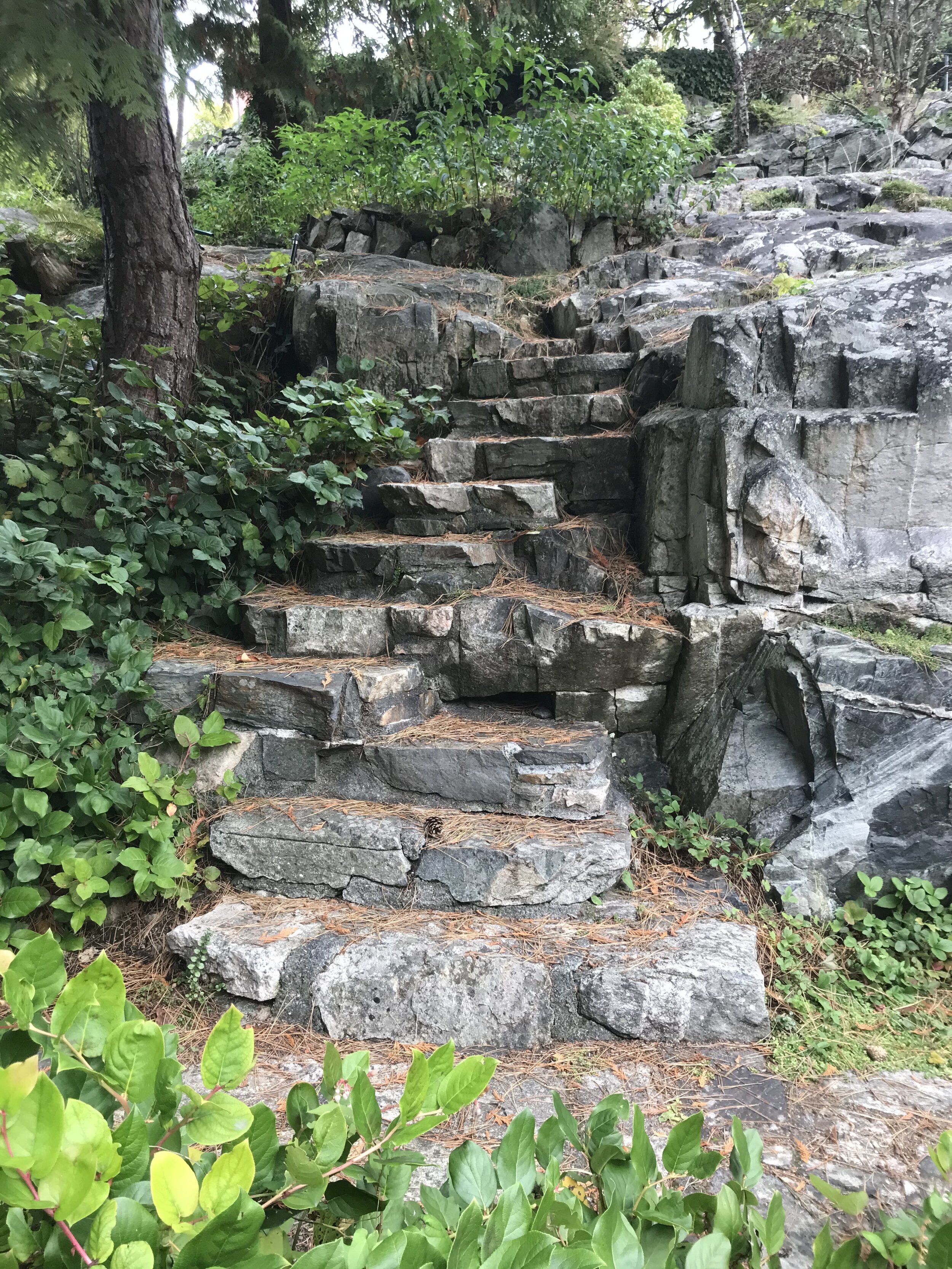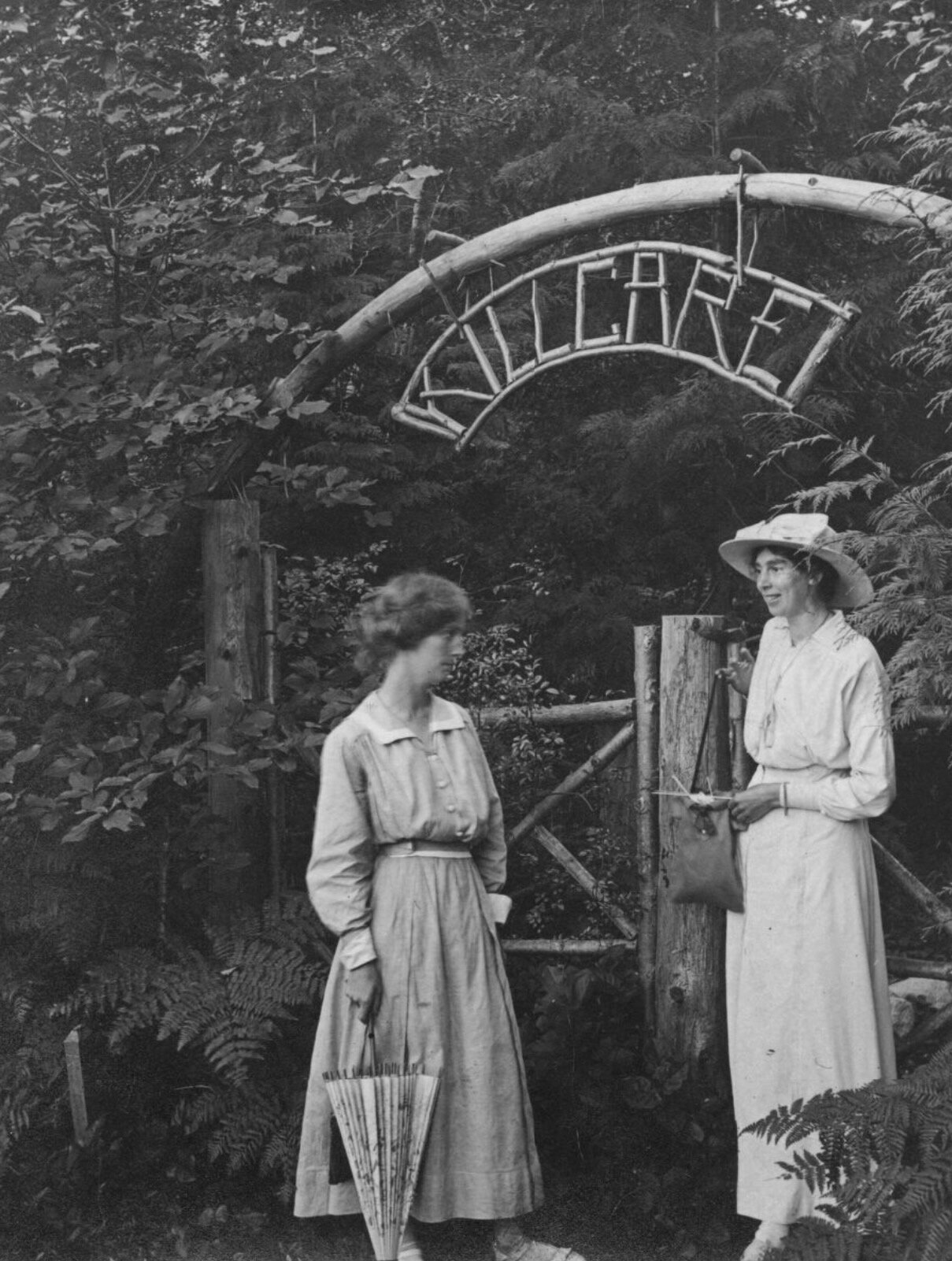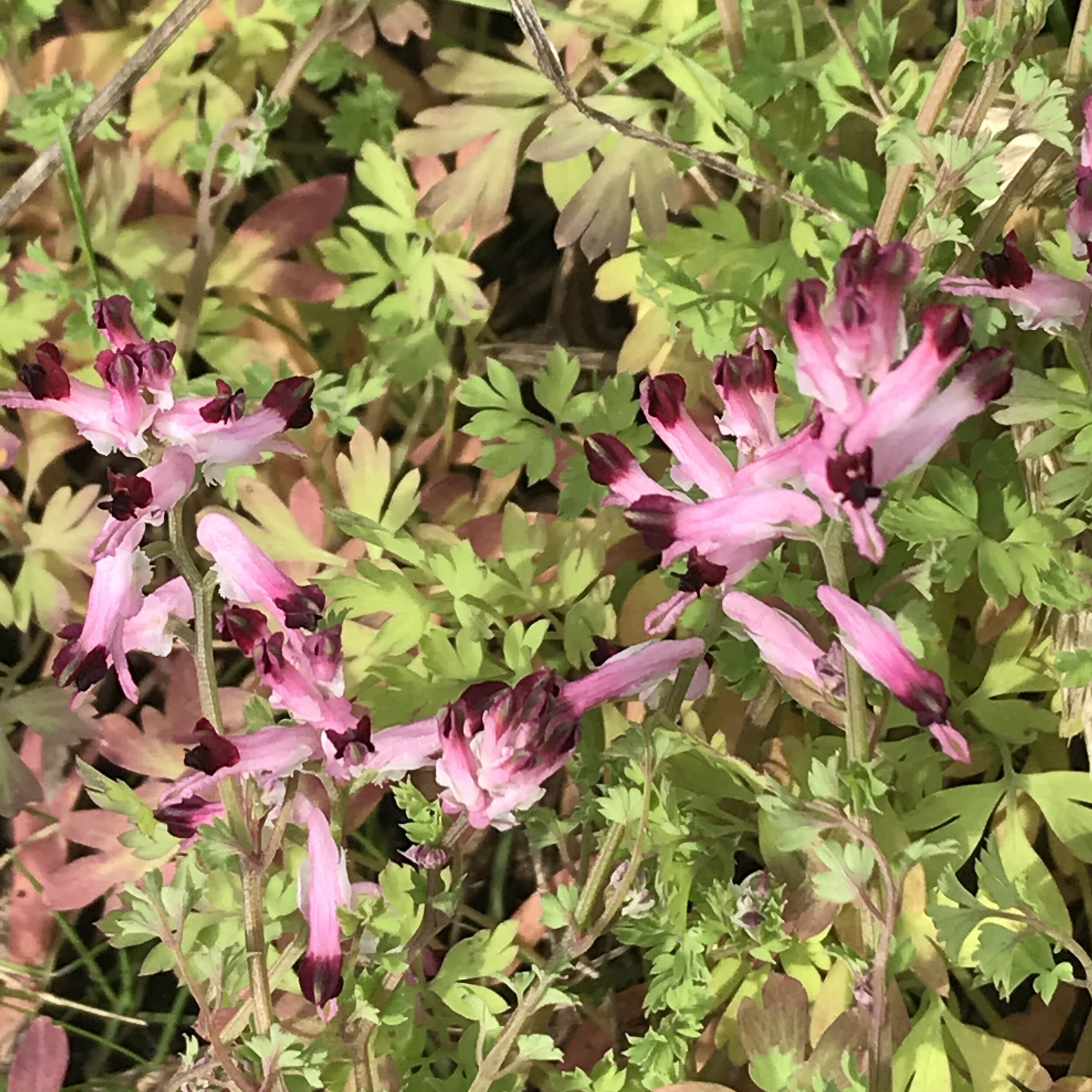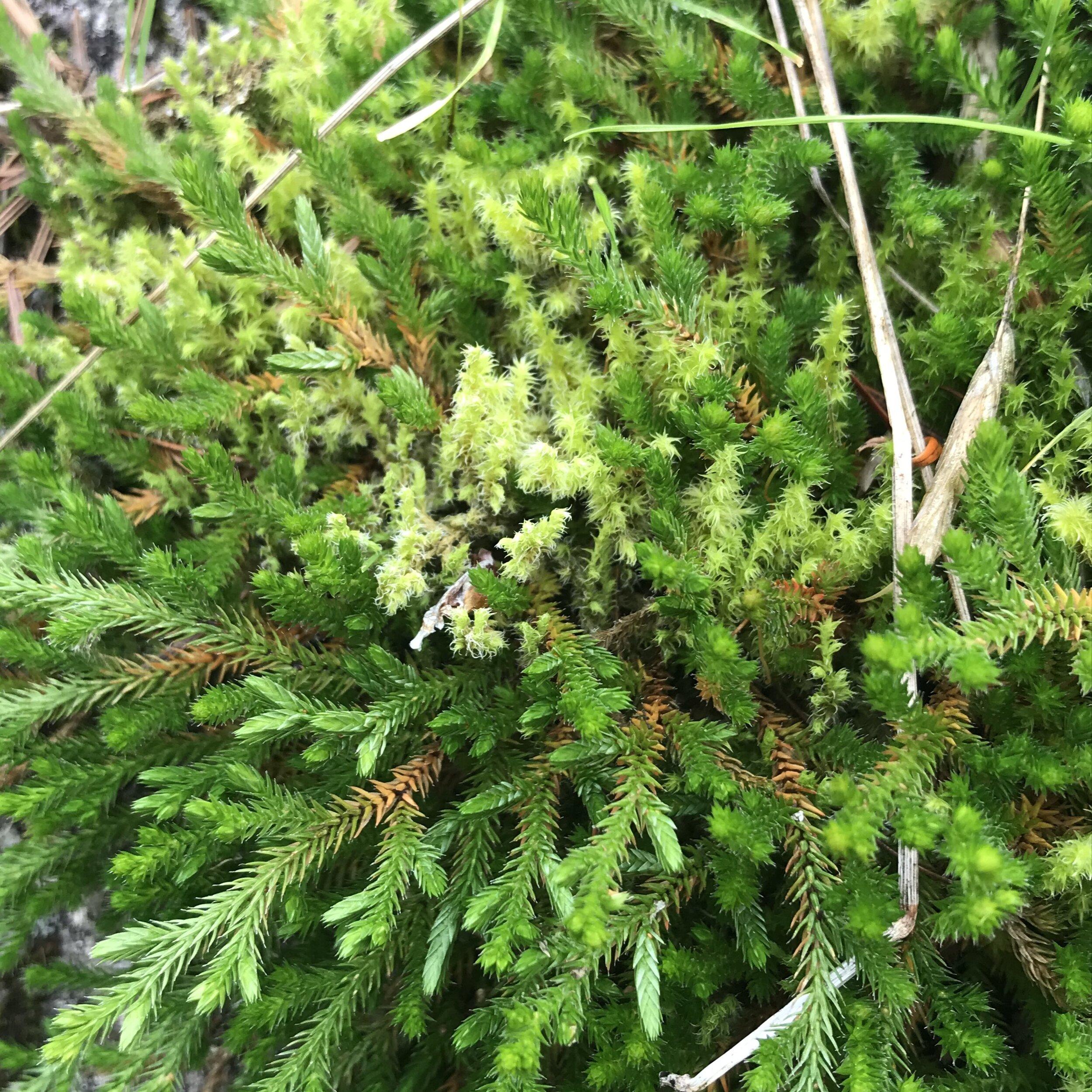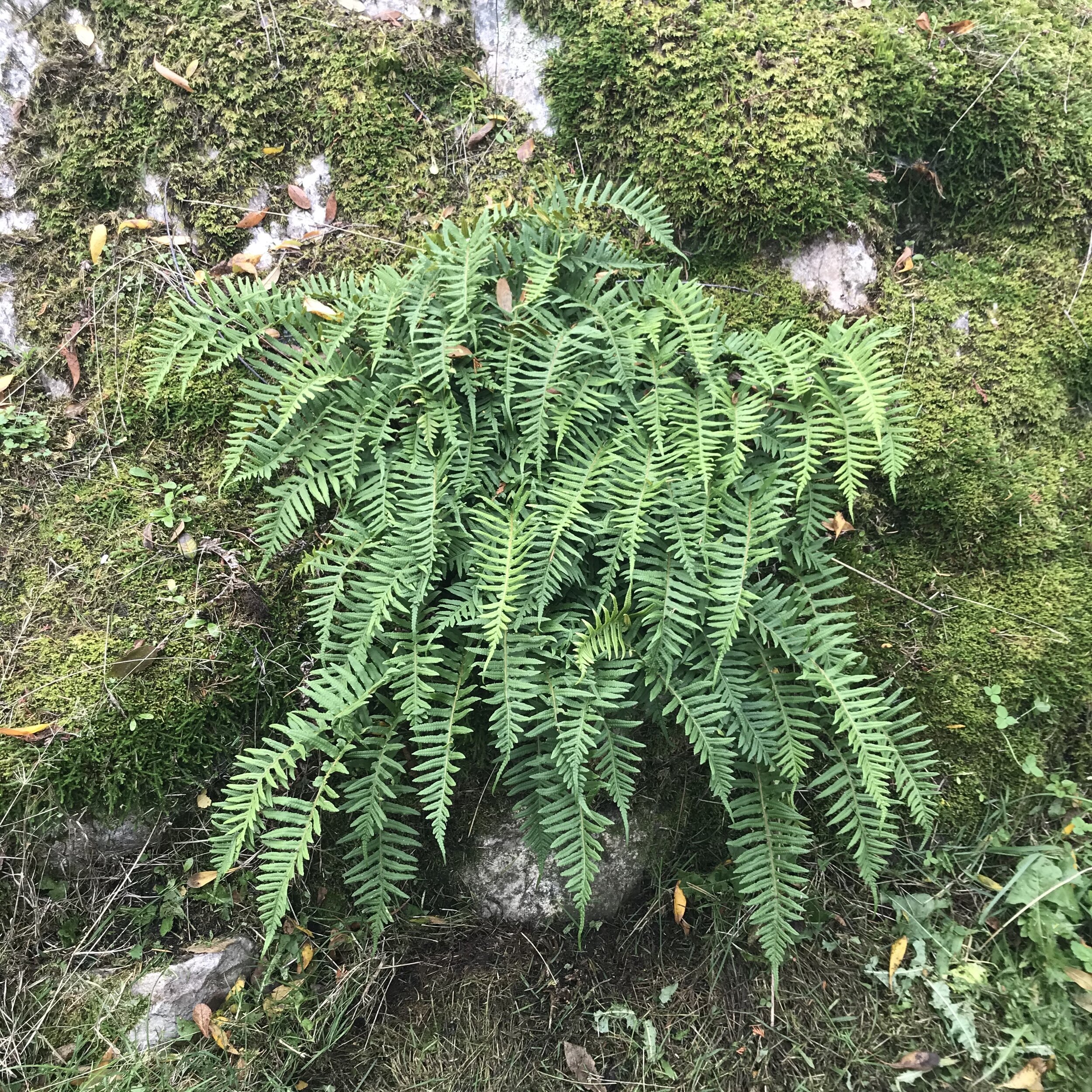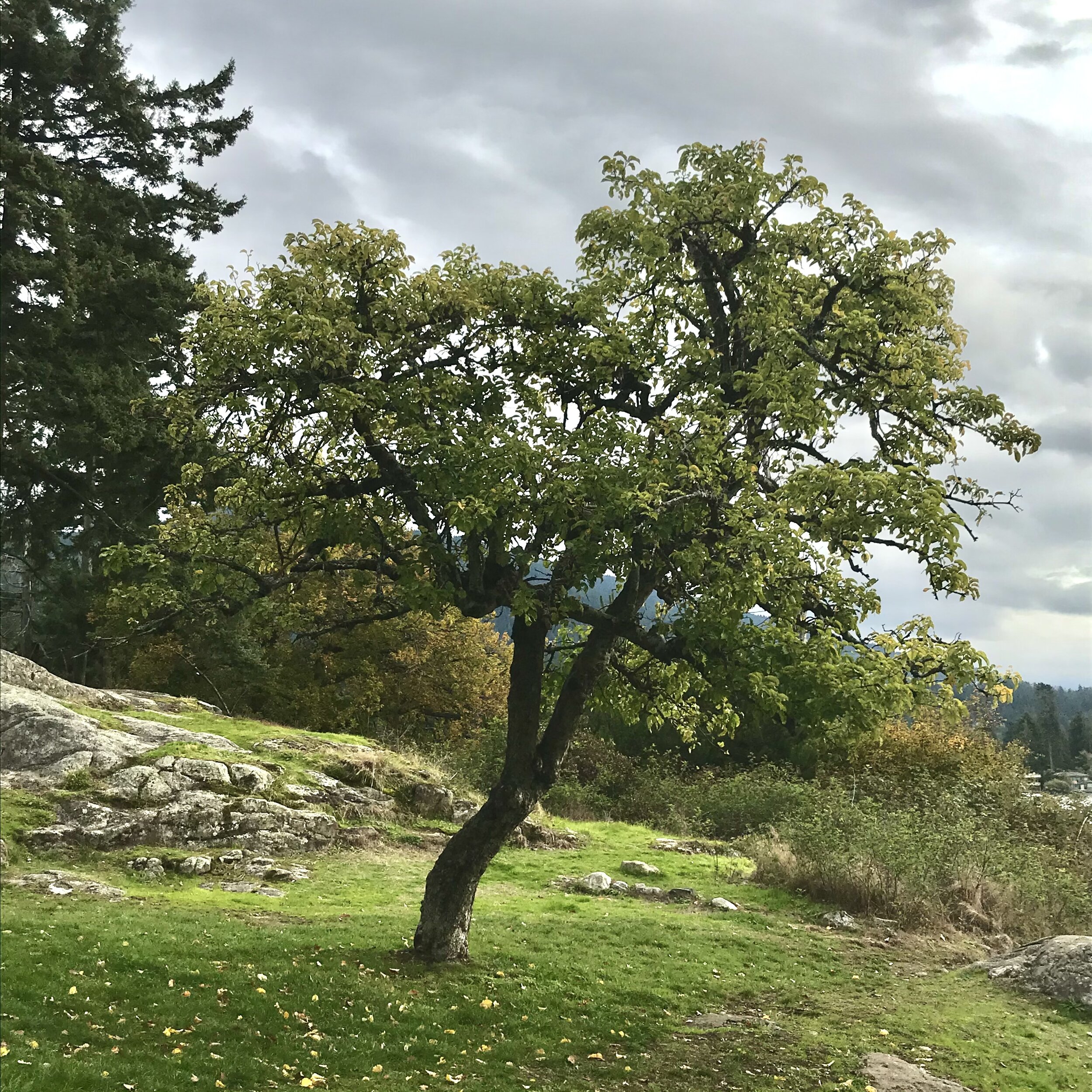(Exploring how Francis Caulfeild’s love of nature helped him to develop a unique coastal community)
When I visited Olde Caulfeild on a hot September morning to take some photos for this article and get a feel for the place, I was immediately struck by the feeling that I had stumbled upon a wonderful secret, like a Brigadoon in the mist. Further to that was the fact that it had rained the night before and the heat of the late morning was creating a fragrant, steamy mist as I followed one of many forested paths from Piccadilly Road to the sea. The scent was so lush and heady, like a rainforest conservatory, but fresher and sweeter. The smooth, glacier rocks on the foreshore were warm and the sun sparkled in the water. I wanted to stay for hours on those rocks and was disappointed I didn’t have the time. Residents meandered on leisurely walks, greeting or stopping to chat with neighbours as they passed. I made my way to the village church and green and found a wedding in full swing on the green, just as weddings had been celebrated there for over a century. I felt like I was in a place time had forgotten, save for the modern cars on the road.
Steam was rising around this forest stream, while the sun-warmed glacier rocks formed part of the pathway along the shoreline as I explored.
So how did such a lovely place get built, and why does it feel so different from many other developments built at the time, or even in present day?
Francis Caulfeild, an English scholar and artist, arrived with his daughter in Vancouver in 1898 on a leisurely tour of Canada, and ended up in Skunk Cove (later renamed Caulfeild Cove) during an excursion with Captain Charles Henry Cates, who dropped the pair off in the Cove for the day. By the time Cates returned to pick them up, Caulfeild had already fallen in love with the enchanting, rugged, natural beauty of the area. He had an intense love for the natural world and was inspired to create a traditional, English-style village where houses would be built into the landscape and where people could enjoy nature’s bounty as a community. Caulfeild respected the landscape as it was and wanted to form building lots without the typical, pioneer-style clearing of the land which was common (and still carries on to this day), that strips the land of trees, shrubs and boulders, before building onto a void, lifeless piece of earth. Instead, he thought every effort should be made to keep large trees wherever possible, and leave large boulders and rocks as they were, recognising the uniqueness of each lot and working with that.
Caulfeild luckily had the financial means to make this dream a reality. Over the next two years he made two large realty transactions in which he purchased a vast estate totalling 390 acres running from Cypress Falls all the way to Howe Sound. It was full of ancient trees, streams, large, glacial boulders and a vast array of flora and fauna. For the next 25 years or so he would put everything he had into building into bringing his vision to life.
There was little existing infrastructure at the time. The cove and the adjoining land was wild and undeveloped, save for the lighthouse at Point Atkinson and a small cottage lived in by the pilot’s assistant at the time, Mr. Grafton, with his family and his cow. Pilots were men who would meet ships at the First Narrows and guide them safely past the dangerous, changeable shallow areas and rip tides to the Port of Vancouver.
Caulfeild’s first task was to build a heavy pier for steamers, such as the SS Britannia, to bring passengers to and from more populated areas to the Cove on a daily basis. Scows could then use the pier to bring building materials for cottages, as this was the only way materials could be brought at the time without any road or rail access. He also added a couple of floats as well for smaller boats to access the cove.
He built a home for his family so his wife and daughter could come from England to join him and a ‘Pilot House’ for the pilots’ assistants to live in and the pilots to stay in, rather than sleeping short-term in their boats. Caulfeild also built a water system from Cypress Creek using wooden pipes to bring the water to the village. It was an arduous, expensive endeavour, but he felt it necessary to complete before people settled there. Early residents were pleased to have full bathrooms with running water, a luxury in rural developments at the time.
Present day Caufeild Cove with the pier in the distance
Caulfeild’s first home built in 1904, and also the first home built in Caulfeild, made possible by the building of the pier.
Courtesy of West Vancouver Memorial Library, (copied from Vancouver Archives photo), registered 0032a.VCA
The streets were created in a winding, English village style which had a charming aesthetic appeal, but it was about much more than aesthetics. Caulfeild believed that streets should follow the contours of the natural landscape, rather than blast through in a straight-lined grid, so he developed the streets with the help of animal paths such as those made by bears, deer and cows. Mr. Grafton’s cow liked to wander and inadvertently helped with the village’s planning. According to H.A. Stone, an early resident of Caulfeild who knew Caulfeild personally, he would often say “The cow is always right.” This idea met with resistance at various levels of governance, as it wasn’t the usual way of doing things, but eventually Caulfeild convinced people he should proceed that way.
By 1909, lot preparation was complete and lots were ready to be offered for sale.
Courtesy of Newspapers.com and the Sat, June 19 edition of The Daily Province
Group of people standing on Caulfeild Cove wharf. Sign on right may read: Lots for Sale
Courtesy of West Vancouver Memorial Library, registered 0487.WVML
As lots sold, homes were built that nestled gracefully into the natural landscape of the building lots, and the new residents seemed to embrace the ideals of living with nature that Caulfeild had intended. Rather than fight the large boulders on their lots, residents built elaborate rock gardens around them, laying dry stone walls and steps with techniques that Caulfeild had taught them, which enhanced and complemented the beauty of these gardens.
Natural arbours and fencing were made from woven and bent tree branches and vines, lending a fairyland-like quality to the village. Flowering trees, fruit trees, oaks, flowers, shrubs, and plants of all kinds were planted to form enchanting gardens into properties that already had abundant natural beauty.
Amy Larnder in photo on left, Amy lander and likely Mrs. George Larnder on right. Both photos are of gates to the Kilby house at 4762 The Highway (address as of 1979). Courtesy of West Vancouver Memorial Library, references of 0473.WVML for left photo, 0472.WVML for right photo.
A woman and a young girl in a flower garden. The side of the Kilby house is in the background.
Rupert Harrison photos collection courtesy of the West Vancouver Archives, reference 1890 WVA.RAH
The rustic landscape, paired with easy access to the ocean and forest, made Caulfeild Village a natural paradise that wasn’t taken for granted. Residents took pleasure in their gardens, walked in the forest, swam on the beach and played badminton or had teas and picnics on the village green.
View of Mrs. Margaret Matthews playing badminton in Caulfeild Courts (present day Caulfeild Green) in the 1920s.
Courtesy of West Vancouver Memorial Library, reference 0578.WVML
View of garden party at badminton courts (present day Caulfeild Green).
Courtesy of West Vancouver Memorial Library, reference 0594.WVML
Kilby Family on steps to Caulfeild Beach (1909).
Courtesy of West Vancouver Archives, reference 1867.WVA.RAH
Group portrait of the Leckie Family at Caulfeild Beach.
Courtesy of West Vancouver Memorial Library, reference 0574.WVML
Caulfeild wanted residents to have perpetual access to the ocean, so he donated the park area of the village and its foreshore as a public park, to make sure development didn’t hinder access to it. To this day, Caulfeild Park and its foreshore (about 1km long) is one of the largest undeveloped areas of Greater Vancouver’s waterfront. It is historically significant as a landing bay for people arriving by boat to the area, but also ecologically significant as it is rich with rare vegetation and also has some of the oldest rocks (200 million years old) in the Vancouver area.
Images clockwise from left corner: Unidentified coastal flower, mosses, lichen, glacial boulders forming pathway, remnant orchard apple tree, wild lilies, beach view looking east, ferns growing out of large boulder.
The challenge of bringing building materials by boat slowed the development of houses in the village, but with the introduction of the short-lived PGE railway in 1914, and the following year, the long-awaited extension of Marine Drive to Caulfeild, the pace picked up rather quickly. Frank and Mary Kettle, who had run Pilot House since 1909, had also been running a general store for a number of years to service the village. Caulfeild’s first cottage later became a store/post office. The village was taking shape and a community began growing out of the coastal landscape. The only thing missing from Caulfeild’s vision was the church.
A lovely, timber-framed church was designed by one of the original residents, H.A. Stone, who had known Caulfeild personally, and it was completed in 1927, on land Caulfeild had donated for the purpose, and in a traditional English style he would have approved of. It was named St. Francis-in-the-Wood and fit the natural theme of the village to a tee. Unfortunately, Caulfeild never saw its completion. He was in his mid-fifties when he began the Caulfeild development, and after 25 years of working on it, he retired back to England at the age of eighty where he lived to be ninety. Fortunately for us, he left behind a lasting legacy of natural beauty and community.
View of St. Francis in the Woods church prior to the addition of Chancel in 1938.
Large sections have since been added. The church is still active as a church, but part of it is used as a Montessori school and the hall portion is rented out for events.
Courtesy of West Vancouver Memorial Library reference 0600.WVML
English-style lychgate at entrance to churchgrounds. Used traditionally for pallbearers to rest and shelter the coffin while waiting for clergyman to arrive. Benches flank each side.
The village green at the foot of the churchyard, still in use today.
That’s not to say that there haven’t been changes; the development has expanded outwards, and parts of it are much less rustic, with large, new houses replacing many modest sized ones. However, many older homes and much of the original charm remains, including a relaxed vibe, neighbours chatting with each other, the original church and village green, walking trails, countless old rock walls, rock gardens, large trees and lovingly tended gardens. A resident chatted with me after I complimented his charming home and flower baskets and he told me his favourite thing about living there is that it’s a neighbourhood; a community where people all know and look out for each other. I think Caulfeild would have been pleased to know that nearly 100 years after he left the area, residents would still be enjoying it together as a community.
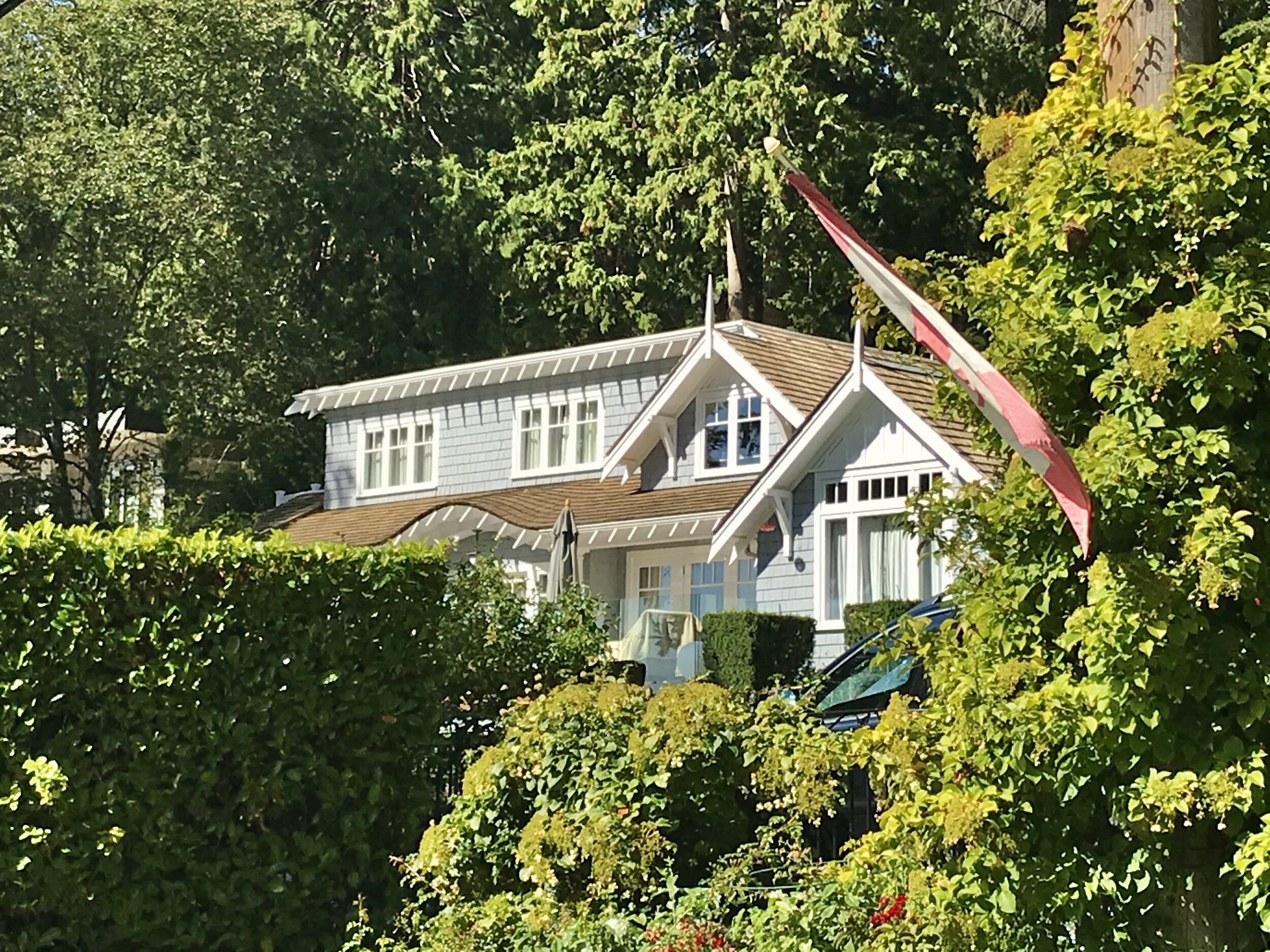
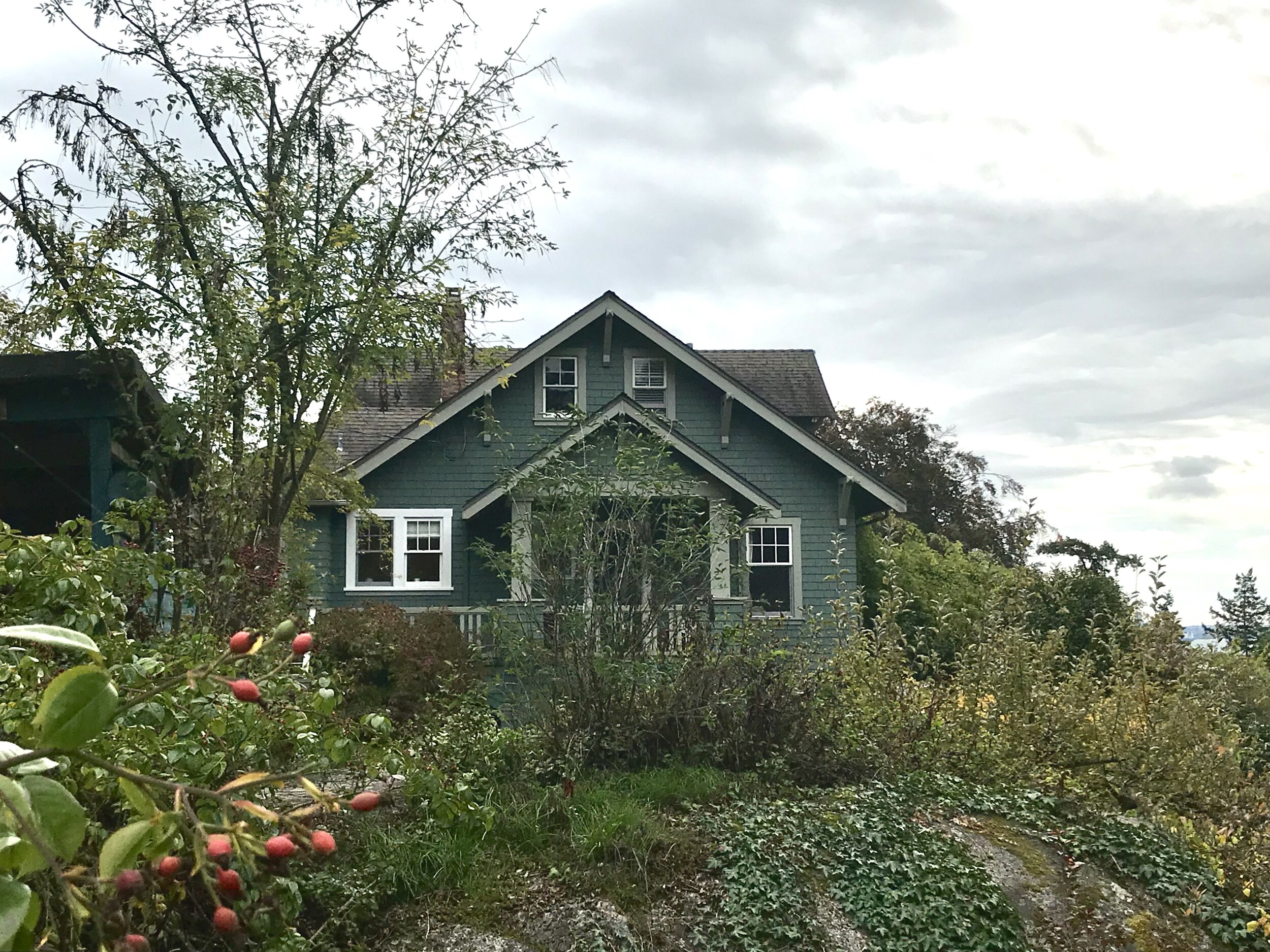
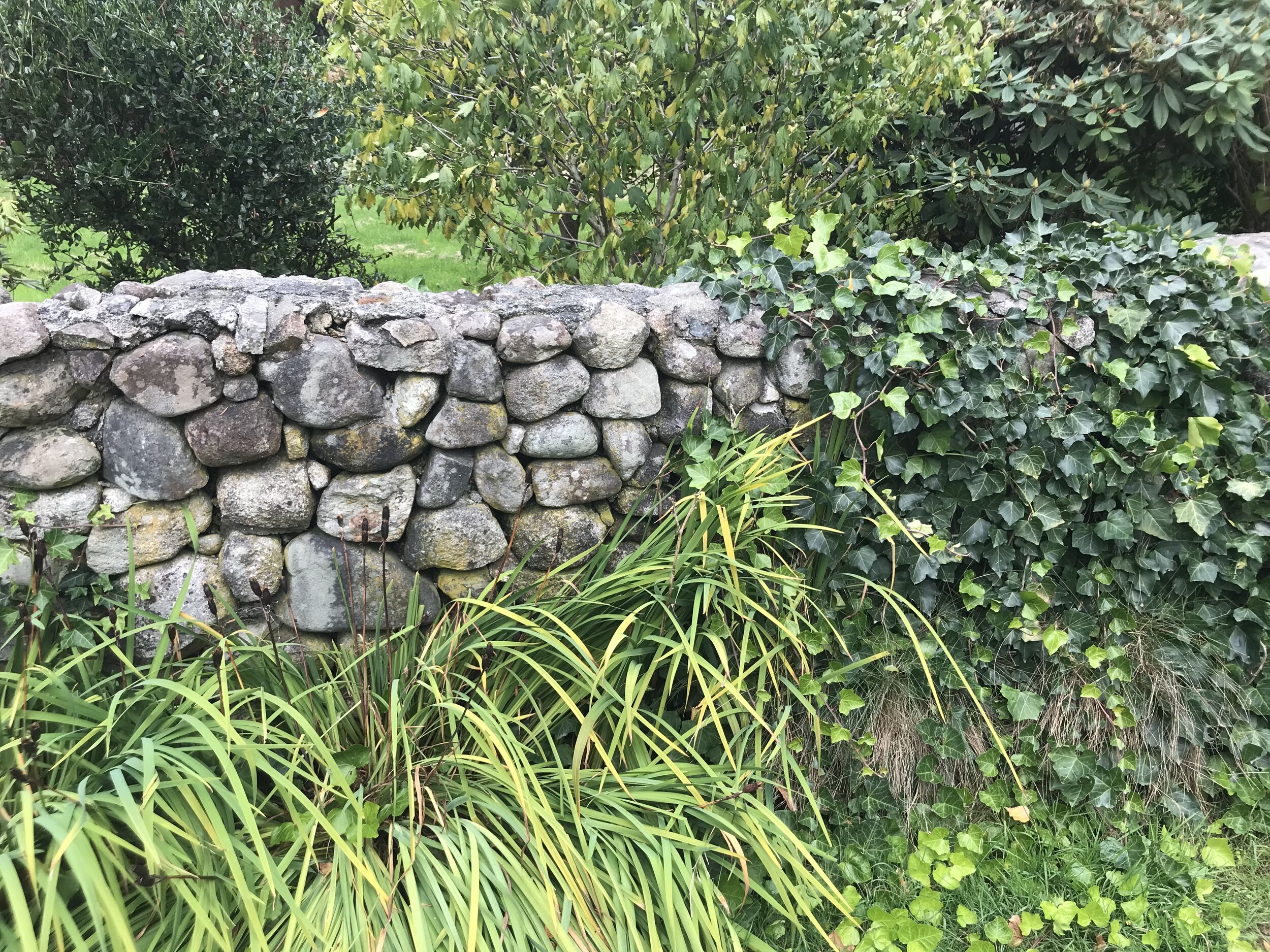
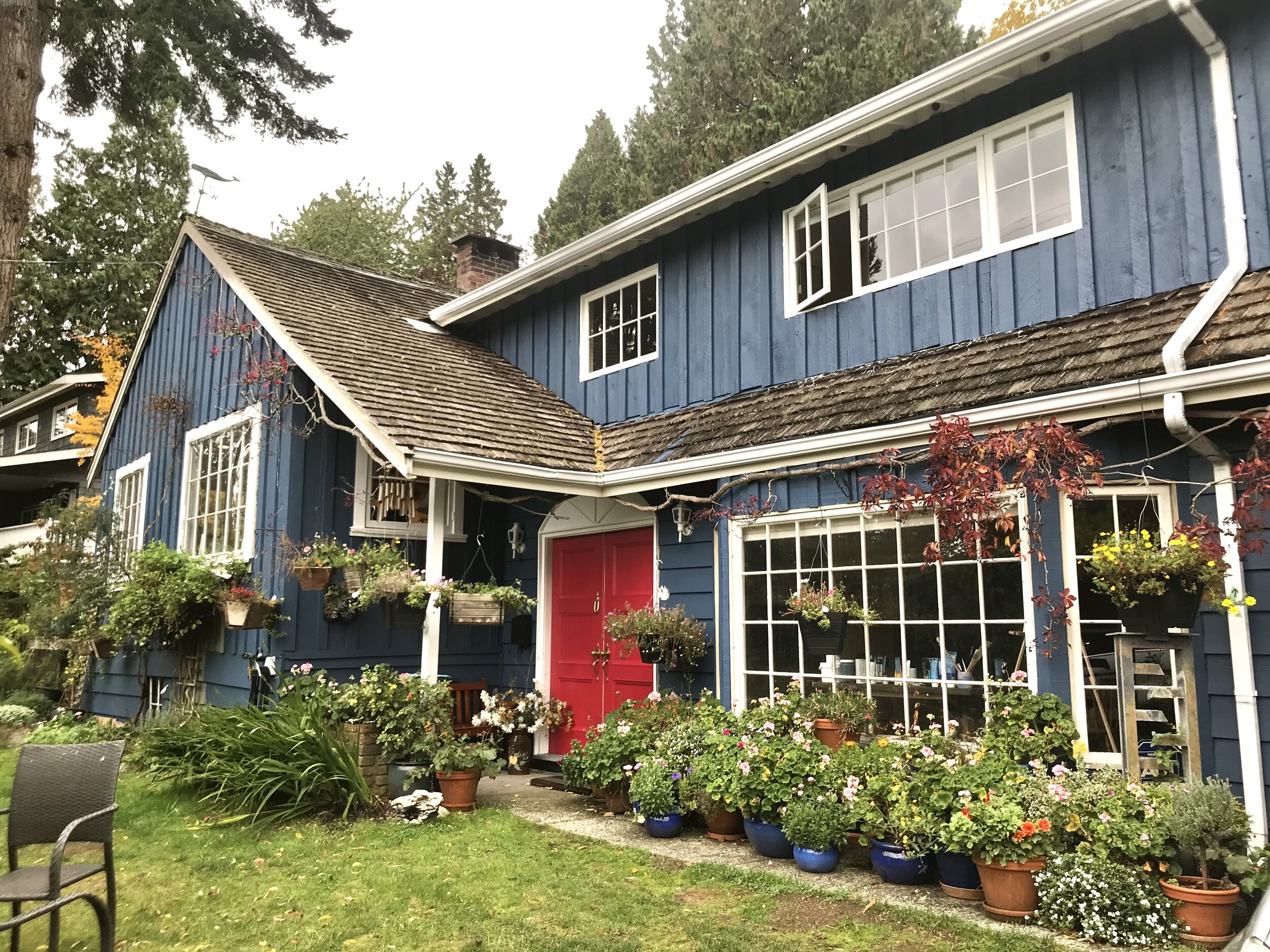
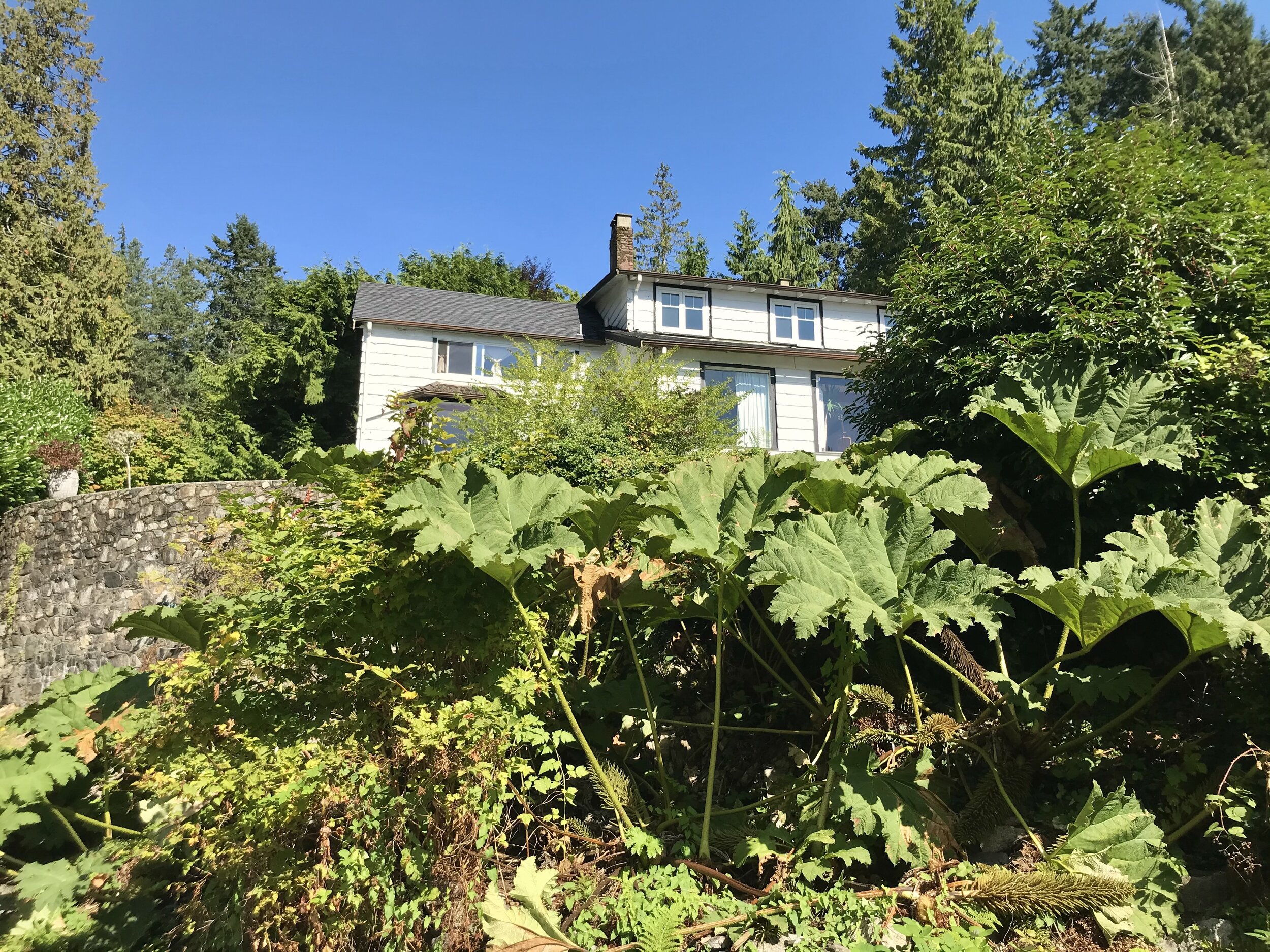
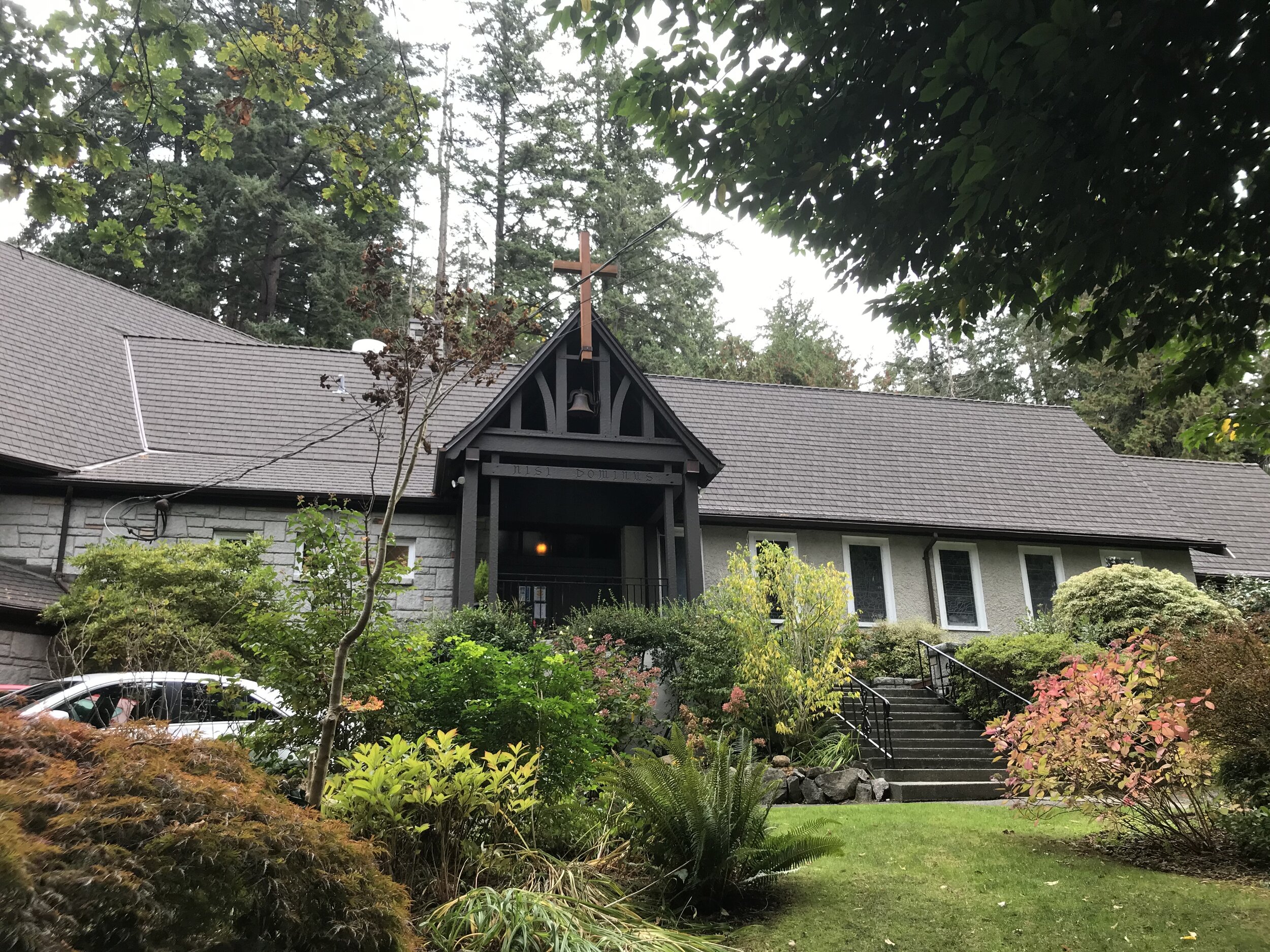
From left to right: Caulfeild family home (1904), the Kilby Family summer home called “Resthaven”, a likely original stone wall, a 1922 cottage with addition, a boisterous garden with gunnera, St.Francis-in-the-Wood.
However lovely the area is, I should give a warning to any visitors planning to enter or leave it quickly. Give yourself a little extra time and bring a relaxed attitude to navigate the narrow, windy roads and one-way streets, for, after a few minutes in the village, you’ll see that Caulfeild truly took it to heart when he said, “The cow is always right”.
Fun Facts
Caulfeild came from Clovelly, a seaside village in northwestern England, and named one of his village streets, ‘Clovelly Walk,’ after it. A number of streets in Caulfeild have English inspired names.
‘Captain’ Frank Kettle and Mary Kettle became close to Caulfeild, even nursing him during a long period of ill-health, and were considered by residents to be the “grandparents of the village” due to their kindness, generosity and involvement in village life.
Caulfeild, during his trips from England to Caulfeild, translated Homer’s Odyssey from Greek to English. He had studied at Oxford in his youth. His book was well received and considered at the time the only correct translation. There is a 1915 newspaper account in the “social” section of The Province telling of Caulfeild reading from his translation to a group of people. It is still widely available for purchase today.
Lower Caulfeild is a Heritage Conservation Area and was the first of its kind in BC. Any work altering a home needs to undergo a review process before any changes are made, to help preserve the heritage of the neighbourhood.H.A. Stone not only designed the local church, he wrote “A Short History of Caulfeild” and he made a tireless effort to establish the Vancouver Art Gallery. He received a Good Citizenship medal for this in 1931 from West Vancouver citizens.
References: A Short History of Caulfeild by H.A. Stone, Cottages to Community by Francis Mansbridge ( West Vancouver Historical Society), West Vancouver Archives, West Vancouver Memorial Library Digital Collections, Newspapers.com
